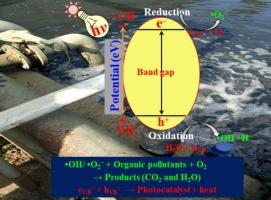The photocatalytic degradation of organic pollutants-a comprehensive overview
IF 4.2
Q2 CHEMISTRY, MULTIDISCIPLINARY
引用次数: 0
Abstract
Photocatalytic degradation is a promising and eco-friendly technology that effectively removes organic pollutants from both air and water. This process relies on light-activated semiconductor catalysts such as TiO2, ZnO, CeO2, g-C3N4, and various heterojunction composites. These materials generate highly reactive species, including hydroxyl radicals and superoxide anions, which are capable of breaking down persistent contaminants into harmless byproducts like carbon dioxide (CO2) and water (H2O). The efficiency of photocatalytic reactions is influenced by several factors, including the catalyst's composition, morphology, crystallinity, bandgap energy, surface area, light intensity, and wavelength. Operational conditions such as pH, contaminant concentration, and the presence of scavengers also play a significant role in determining the effectiveness of the process. Recent advancements in photocatalysis have focused on addressing challenges associated with conventional catalysts, such as limited response to visible light and fast recombination of charge carriers. Techniques such as surface modification, doping, the development of Z-scheme and S-scheme heterojunctions, and integration with carbon-based materials have been explored to enhance performance. This review provides an overview of the fundamental principles of photocatalysis, recent innovations in catalyst design, and the mechanisms involved in pollutant degradation. To translate this technology into practical, scalable solutions for reducing organic waste in the modern era, further interdisciplinary research and the development of cost-effective, visible-light-responsive, and durable photocatalysts are essential.

光催化降解有机污染物综述
光催化降解是一种有前途的环保技术,可以有效地去除空气和水中的有机污染物。该工艺依赖于光活化半导体催化剂,如TiO2、ZnO、CeO2、g-C3N4和各种异质结复合材料。这些材料产生高活性物质,包括羟基自由基和超氧阴离子,它们能够将持久性污染物分解成无害的副产品,如二氧化碳(CO2)和水(H2O)。光催化反应的效率受多种因素的影响,包括催化剂的组成、形貌、结晶度、带隙能、比表面积、光强和波长。操作条件,如pH值、污染物浓度和清除剂的存在也在决定过程的有效性方面起着重要作用。光催化的最新进展主要集中在解决与传统催化剂相关的挑战,例如对可见光的有限响应和电荷载流子的快速重组。为了提高性能,研究人员探索了表面改性、掺杂、z -图式和s -图式异质结的发展以及与碳基材料的集成等技术。本文综述了光催化的基本原理、催化剂设计的最新创新以及污染物降解的机制。为了将这项技术转化为实用的、可扩展的解决方案,以减少现代时代的有机废物,进一步的跨学科研究和开发具有成本效益、可见光响应和耐用的光催化剂是必不可少的。
本文章由计算机程序翻译,如有差异,请以英文原文为准。
求助全文
约1分钟内获得全文
求助全文

 求助内容:
求助内容: 应助结果提醒方式:
应助结果提醒方式:


